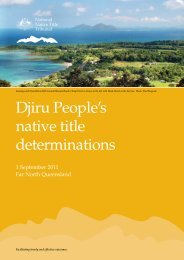Biodiveristy_State of Environment report - Mission Beach Cassowaries
Biodiveristy_State of Environment report - Mission Beach Cassowaries
Biodiveristy_State of Environment report - Mission Beach Cassowaries
- No tags were found...
Create successful ePaper yourself
Turn your PDF publications into a flip-book with our unique Google optimized e-Paper software.
conservation covenant.This can includes examples such as:• Subdivision one bonus (additional) block per 5 ha <strong>of</strong>habitat put into conservation to a maximum <strong>of</strong> 4bonuses.• Additional house - again one bonus per 5 ha habitat to amax <strong>of</strong> four bonuses.• More intense development - Backpackers, Eco-tourismtype development. For example, a rural conservationblock in the <strong>Mission</strong> <strong>Beach</strong> area put 90% <strong>of</strong> the block inconservation and developed an Ecotourism typeaccommodation facility. The area is classified ascritical habitat. The remaining 10% was set aside fordevelopment but in reality only a quarter <strong>of</strong> that hasactually been used for development.WTMA CovenantsTwo covenants with the Wet Tropics ManagementAuthority (WTMA) exist on properties at Bingil Bay. Thearea <strong>of</strong> these is approximately 30 hectares. The WTMA ispresently encouraging landowners to utilise the ShireCouncil for covenants.Land for WildlifeLand for Wildlife agreements are another incentive topromote the conservation <strong>of</strong> vegetation on private land.Landholders receive expert advice to assist them inmanaging and conserving native vegetation and fauna.At the end <strong>of</strong> 2004 there were eight Land for Wildlifeproperties in the Shire. The total vegetation on this landhad an area <strong>of</strong> 218.9 hectares.Australian Rainforest FoundationThe Australian Rainforest Foundation is a not for pr<strong>of</strong>itorganisation that is working towards establishing acontinuous length <strong>of</strong> connectivity between Cairns andCardwell. So far, two 15 hectare blocks have beenpurchased at <strong>Mission</strong> <strong>Beach</strong>. The blocks have since beensold to private owners, but with over 95% <strong>of</strong> their areassealed under <strong>State</strong> covenants. These covenants completelyrestrict development in the conservation area and areperpetual.RestorationRevegetation and RehabilitationThe Revegetation Unit is responsible for the majority <strong>of</strong>revegetation and rehabilitation work conducted in theShire, either directly, or through the provision <strong>of</strong> technicaladvice to landholders. Staff to perform the core duties isprovided through Council, but the majority <strong>of</strong> the wagesare funded through the Natural Heritage Trust (NHT).Surrounding the staff are almost a hundred volunteers,willing to assist at the nursery or with planting days.The NHT has funded the majority <strong>of</strong> the work currentlybeing undertaken in the Johnstone Shire. Council hasundertaken most <strong>of</strong> this work, along with the invaluableefforts <strong>of</strong> community group involvement.In 2004/2005 revegetation projects were undertaken in thefollowing areas:Revegetation and RehabilitationRehabilitation does not have to specifically deal withtraditional revegetation techniques, it can involve acombination <strong>of</strong> strategies that enhance and promote theestablishment <strong>of</strong> native vegetation. A successfulrehabilitation project will almost certainly involve acombination <strong>of</strong> remnant rehabilitation, enrichment planting,revegetation and promotion <strong>of</strong> natural regeneration throughstrategic weed control. An integration <strong>of</strong> severalrehabilitation techniques minimises costs, leads to richerspecies diversity and quicker site capture.Costs for traditional revegetation projects average around$15,000 per hectare but can be as little as $6,000 to $7,000.The actual cost ultimately depends on how much in-kindsupport can be received for the project. In-kind support canbe provided by volunteers in the form <strong>of</strong> labour, or where alandholder undertakes work to prepare or maintain theproposed rehabilitation site.The more in-kind support received the further the dollargoes. In fact, for every dollar <strong>of</strong> NHT funding providedthere is about two dollars <strong>of</strong> in kind support provided by thecommunity and/or local government. Without this support,revegetation would simply not occur in the Wet Tropicsarea.Projects the Revegetation Unit received funding for:35



